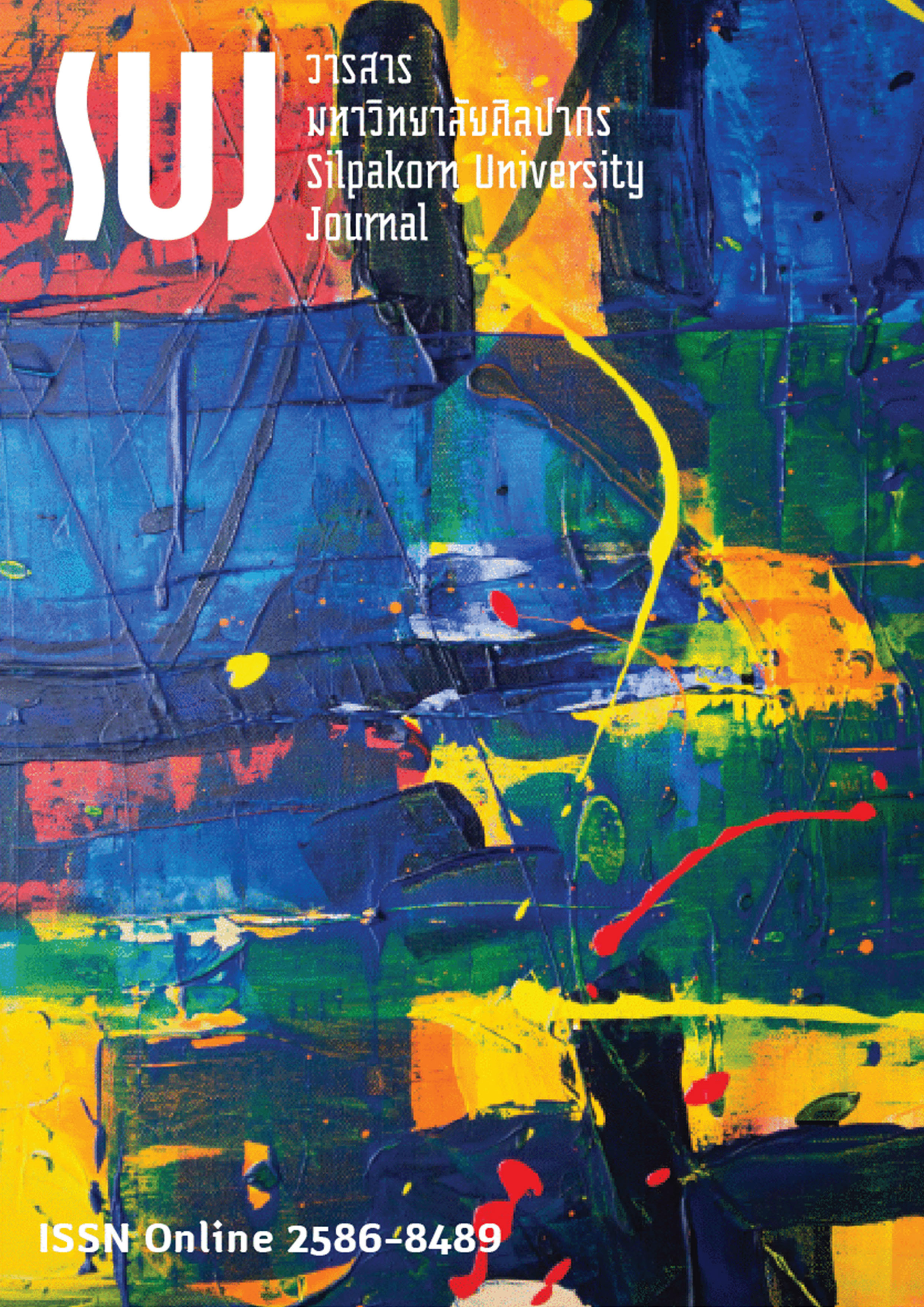การวิเคราะห์ข้อมูลกะโหลกมนุษย์โดยใช้หลักการวิเคราะห์วัตถุสารสนเทศ (Analysis of the human skull data using information object analysis concept)
Main Article Content
Abstract
กะโหลกเป็นส่วนสำคัญของมนุษย์ในการวิเคราะห์ทางนิติเวชเพื่อค้นหาคุณลักษณะของบุคคลและนำไปสู่การวินิจฉัยตัวบุคคลได้ การจัดการข้อมูลกะโหลกอย่างเป็นระบบและสอดคล้องกับการนำไปใช้ประโยชน์ทางการแพทย์ โดยเฉพาะอย่างยิ่งทางนิติมานุษยวิทยาจึงมีความสำคัญอย่างยิ่ง งานวิจัยนี้มีวัตถุประสงค์เพื่อวิเคราะห์ข้อมูลกะโหลกมนุษย์ ตามหลักการวิเคราะห์วัตถุสารสนเทศของ Gilliland (2016) ซึ่งดำเนินการวิจัยโดยใช้วิธีการเชิงคุณภาพ ประกอบด้วย การวิเคราะห์เนื้อหา โดยอ้างอิงข้อมูลกะโหลกคนไทยจากงานวิจัยของ Tuamsuk, Nonsrijun, & Sirisin (2013) และการสัมภาษณ์แพทย์ผู้เชี่ยวชาญด้านกายวิภาคศาสตร์และด้านนิติเวชศาสตร์ จำนวน 4 คน โดยวิธีสโนว์บอล โดยใช้แบบบันทึกข้อมูลการสัมภาษณ์ ผลการวิจัยสรุปว่า กะโหลกมนุษย์ ซึ่งในงานวิจัยนี้ถือว่าเป็นวัตถุสารสนเทศ (information object) มีองค์ประกอบของข้อมูล 3 ด้าน คือ 1. ข้อมูลเนื้อหา (content data) ประกอบด้วย ข้อมูลกระดูก และข้อมูลตำแหน่งอ้างอิง (landmark) 2. ข้อมูลบริบท (context data) ประกอบด้วย ข้อมูลเจ้าของกะโหลก เช่น เพศ อายุ เชื้อชาติ น้ำหนัก ส่วนสูง และภาพกะโหลก เป็นต้น และ 3. ข้อมูลโครงสร้าง (structure data) ประกอบด้วย ข้อมูลความยาวของกะโหลก และดัชนีกะโหลก ผลจากการวิจัยนี้ทำให้ได้ชุดข้อมูลและรายละเอียดข้อมูลที่สามารถนำไปพัฒนาเมทาดาทาและคลังข้อมูลกะโหลก เพื่อประโยชน์ในการศึกษาทางการแพทย์และการวิเคราะห์คุณลักษณะกะโหลกเพื่อระบุตัวบุคคลในทางนิติมานุษยวิทยา
The skull is an integral part of the human forensic analysis to identify characteristics of a person and to lead to the diagnosis of individual. Management of human skull and cranial data systematically in accordance with clinical uses, especially in forensic anthropology, is crucial. The objective of this research was to analyze human skull data based on Gilliland's Principles of Information Object Analysis (2016). The research was conducted using a qualitative method consisting of content analysis based on the data of Thai skulls from Tuamsuk, Nonsri่jun, & Sirisin (2013)’s research, and interviews with four doctors specializing in anatomy and forensic medicine by using a snowball sampling technique and interview record form. The results of the study concluded that the human skull, which in this research considered to be an Information Object, has three aspects of data elements: 1. content data consisting of bone data and landmark data 2. context data consisting of skull owner data such as gender, age, race, weight, height, and skull image, and 3. structure data containing length of the skull and cranial index data. The results of this research have yielded a data set and detailed data that can be used to develop metadata and data warehouses for the benefit of medical studies and cranial index analysis to identify individuals in forensic anthropology.
Downloads
Article Details

This work is licensed under a Creative Commons Attribution-NonCommercial-NoDerivatives 4.0 International License.
References
Ahamed, S. V. (2013). Intelligent Networks: Recent Approaches and Applications in Medical Systems. Amsterdam: Elsevier.
Boonprakob, Yodchai. (1993). Cranionmetric and Cranioscopic Studies of Skulls Collected in North-East Thailand (การศึกษาทางมนุษยวิทยากายภาพของกะโหลกคนไทยที่รวบรวมในภาคตะวันออกเฉียงเหนือ). Master’s dissertation, Khon Kaen University, Khon Kaen, Thailand.
Boyd, D. C. (1996). Skeletal Correlates of Human Behavior in the Americas. Journal of Archaeological Method and Theory, 3(3): 189-251.
Chanpak, Supitchaya. (2009). The Study of Guidelines for Improvement of Exhibition in the Museum of Anatomy Kong Don (การศึกษาแนวทางการปรับปรุงการจัดแสดงในพิพิธภัณฑ์กายวิภาคศาสตร์คองดอน). Bangkok: Mahidol University.
Chapman, R., Kinnes, I., & Randsborg, K. (Eds.). (1981). The Archaeology of Death. London: Cambridge University Press.
Corruccini, R. S. (1974). An Examination of the Meaning of Cranial Discrete Traits for Human Skeletal Biological Studies. American Journal of Physical Anthropology, 40(3): 425-445.
DiGangi, A. D., & Moore, M. K. (2014). Research Methods in Human Skeletal Biology. Oxford, UK: Academic Press.
Gilliland, A. J. (2016). Setting the Stage. In M. Baca (Ed.), Introduction to Metadata (3rd ed.). Los Angeles: Getty Publications. [Online]. Retrieved March 11, 2021 from https://www.getty.edu/publications/intrometadata/setting-the-stage/
Glen, S. (2014). Snowball Sampling: Definition, Advantages, and Disadvantages. [Online]. Retrieved February 2, 2021 from https://www.statisticshowto.com/snowball-sampling/
Houck, M. (Ed.). (2017). Forensic Anthropology. Cambridge, MA: Academic Press.
Namking, Maliwan. (2016). Skeleton System (ระบบกระดูก). In Malinee Kerdkoonchon et al. (Eds.), Basic Anatomy 1 (กายวิภาคศาสตร์พื้นฐาน 1), (pp. 109-148). Khon Kaen: Faculty of Medicine, Khon Kaen University.
National Electrical Manufacturers Association (NEMA). (2021). DICOM Information Model: Information Object Definition. [Online]. Retrieved March 11, 2021 from https://dicom.nema.org/medical/dicom/current/output/chtml/part04/chapter_6.html#sect_6.1
Nilprapan, Anucha. (1996). Three-Dimensional Analysis of Thai Skulls Collected in Northeast Thailand (การวิเคราะห์พิกัดสามมิติของกะโหลกคนไทยที่รวบรวมในภาคตะวันออกเฉียงเหนือ). Master’s dissertation, Khon Kaen University, Khon Kaen, Thailand.
Office of the Council of State. (2013a). Act of Ancient Sites, Antiquities, Artifacts, and National Museums, A.D. 1961 (พระราชบัญญัติโบราณสถาน โบราณวัตถุ ศิลปวัตถุ และพิพิธภัณฑสถานแห่งชาติ พ.ศ. 2504. Bangkok: OCS.
Office of the Council of State. (2013b). Act of Ancient Sites, Antiquities, Artifacts, and National Museums, (Issue No.2) A.D. 1992 (พระราชบัญญัติโบราณสถาน โบราณวัตถุ ศิลปวัตถุ และพิพิธภัณฑสถานแห่งชาติ (ฉบับที่ 2) พ.ศ. 2535). Bangkok: OCS.
Phillips, V. M. (2001). Skeleton Remains Identification by Facial Reconstruction. Forensic Science Communication, 3(1). [Online]. Retrieved March 11, 2021 from https://archives.fbi.gov/archives/about-us/lab/forensic-science-communications/fsc/jan2001/phillips.htm
Princess Maha Chakri Sirindhorn Anthropology Center. (2009). Thailand Physical Anthropology Database (ฐานข้อมูลมานุษยวิทยากายภาพในประเทศไทย). Bangkok: SAC.
Renfrew, C., & Bahn, P. (1993). Archaeology Theories, Methods and Practice. London: Thames and Hudson.
Saengwichian, Sanjai (Ed.). (2007). Physical Anthropology of Skulls and Skeletons of Thai People (ลักษณะทางมานุษยวิทยากายภาพของกะโหลกและกระดูกคนไทย). Bangkok: Department of Anatomy, Faculty of Medicine Siriraj Hospital, Mahidol University.
Schmidt, A., & Otto, B. (n.d.). A Method for the Identification and Definition of Information Objects. [Online]. Retrieved February 2, 2021 from http://mitiq.mit.edu/ICIQ/Documents/IQ%20Conference%202008/Papers/3A-2%20Schmidt%20and%20Otto.pdf
Srisai, Meechai, Tansathit, Thanwa, Supiyapan, Pakpoom, & Seetisarn, Boonthiang. (1998). Applied Gross Anatomy Vol.2: Head and Neck (มหกายวิภาคศาสตร์ประยุกต์ เล่ม 2: ศีรษะและคอ) (3rd ed.). Bangkok: Yearbook Publisher.
The Royal Academy. (1984). Dictionary of Medical Terms, English-Thai (พจนานุกรมศัพท์แพทย์ อังกฤษ-ไทย) (4th ed.). Bangkok: The Royal Academy.
The Visual Resources Association. (2020). Data Standards FAQs. [Online]. Retrieved August 5, 2021 from https://vraweb.org/resources/cataloging-metada/ta-and-data-management/data-standards-faqs/
Tirado-Ramos, A., Hu, J., & Lee, K. P. (2002). Information Object Definition-based Unified Modeling Language Representation of DICOM Structure Reporting. Journal of American Medical Information Association, 9(1): 63-72.
Tuamsuk, Panya, Nonsrijun, Nongnuch, & Sirisin, Juthatip. (2013). Craniometry Study of 3D-Human Skulls in Srinagarind Hospital, Khon Kaen University, Thailand. In Proceedings of the 37th Annual Conference of the Anatomy Association of Thailand, pp. 213-215. Phitsanulok: Naresuan University.
Woodley, M. S. (2016). Metadata Matters: Connecting People and Information. In Murtha Baca (Ed.), Introduction to Metadata (3rd ed.). Los Angeles: Getty Research Institute.


